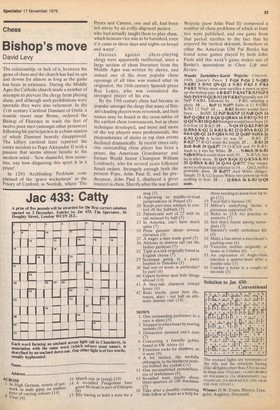Chess
Bishop's move
David Levy
The relationship, or lack of it, between the game of chess and the church has had its ups and downs for almost as long as the game has been in existence. During the Middle Ages the Catholic church made a number of attempts to prevent the clergy from playing chess, and although such prohibitions were sporadic they were also vehement. In the 11th century Cardinal Damiani of Ostia, a seaside resort near Rome, ordered the Bishop of Florence to wash the feet of twelve poor men (amongst other penances) following his participation in a chess session of which Damiani heartily disapproved. The killjoy cardinal later reported the entire incident to Pope Alexander II with a passion that seems almost lunatic to the modern mind — 'how shameful, how senseless, nay how disgusting this sport is in a priest'.
In 1291 Archbishop Peckham complained of the 'grave wickedness' at the Priory of Coxford, in Norfolk, where 'The Priors and Canons, one and all, had been led astray by an evilly-disposed person . who had actually taught them to play chess, which heinous vice was to be banished, even if it came to three days and nights on bread and water'.
Decrees against chess-playing clergy were apparently ineffectual, since a large section of chess literature from the Middle Ages was written by clerics, and indeed one of the most popular chess openings of all time was named after its originator, the 16th-century Spanish priest Ruy Lopez, who was considered the strongest player of his era.
By the 19th century chess had become so popular amongst the clergy that many of Britain's leading players were reverends, and their names may be found in the cross-tables of the earliest chess tournaments, but as chess technique developed, and more and more of the top players were professionals, the preponderance of clerics in top class events declined dramatically. In recent times only one outstanding chess player has been a priest, the American Grandmaster and former World Junior Champion William Lombardy, who for several years followed Jesuit orders. Strangely enough both the present Pope, John Paul II, and his predecessor„lohn Paul I, displayed a great interest in chess. Shortly after the war Karol Wojtyla (now John Paul II) composed a number of chess problems of which at least two were published, and one game from that period testifies to the fact that he enjoyed the tactical skirmish. Somehow or other the American GM Pal Benko has found some games played by both John Pauls and this week's game makes use of Benko's annotations in Chess Life and Review.
Wanda Zartobliwy-Karol Wojtyla: Cram*, 1946, Queen's Pawn, 1 P-Q4 P-Q4 2 N-QB3 N-KB3 3 B-N5 QN-Q2 4 N-B3 P-K3 5 P-K4 P-KR3! White must now sacrifice a pawn or give up the bishop pair. 6 ft-R4!? P-KN4 7 B-N3 NxP NxN PxN 9N-Q2 B-N2 10 P-KR4 Naturally not 10 NxP P-KB4, followed by • , P-85, winning a piece. 10 . . . BxP 11 NxP?! Safer is 11 P-OB3 B: -N2 12 NxP. 11 . . . B-B3 Better would have been. . BxNP, 12 PxP BxKNP 13.NxB QxN 14 BxP -004 15 B-Q6 Q-QR4ch 16 P-03 Q-N3 17 Q-Q2 N-B3 18 Q-B4 Stronger would have been 18 0-0-0 or 18 B-K.5! 18. . . N-Q4 19 Q-K5 P-B3 20 Q-R5ch K-Q2 21 B-R3 K-B2 22 Q-B7ch B-Q2 23 0-0-0 QR-Q1 24 P-QB4 N-N5 25 QxBP NxPch 26 K-N1 Q-N6 A better try was 26 . B-R5. 27 B-K2? 27 R-Q3 traps the knight. 27. . . 0-03 28 RxR RxR 29 QxKP? 29 O-K5ch and 30 R-R3! leads to a win for White. 29 . . N-B6ch 30 K-B1 NxBch Black could draw with 30 . . . N-R7ch, but he is after more. 31 QxN R-Q6 32 Q-K7ch K-N3 33 Q-B5ch K-R3 34 Q-N4 Q-R7?! This trappy move is objectively inferior to 34, . . Qx(), with a probable draw. 35 RxP?? And White obliges. Simply 35 K-Q2 leaves White two pawns up with nothing to fear. 35 . . . 36 K-B2 Q-Q8 mate.






































 Previous page
Previous page